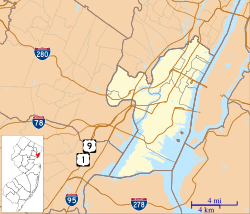Barrow Mansion facts for kids
|
Dr. William Barrow Mansion
|
|
|
U.S. Historic district
Contributing property |
|

The Barrow Mansion in 2010.
|
|
| Location | 83 Wayne Street, Jersey City, New Jersey |
|---|---|
| Area | 0.1 acres (0.040 ha) |
| Built | 1835-1837 |
| Architect | Van Vorst, Cornelius |
| Architectural style | Greek Revival |
| NRHP reference No. | 77000872 |
Quick facts for kids Significant dates |
|
| Added to NRHP | May 2, 1977 |
The Dr. William Barrow Mansion is a historic building in Jersey City, New Jersey. You can find it at 83 Wayne Street. This beautiful old house was added to the National Register of Historic Places on May 2, 1977. It is part of the larger Van Vorst Park Historic District. This district was recognized on March 5, 1980.
Contents
The Mansion's Early History
The Barrow Mansion was built between 1835 and 1837. It was one of two similar homes constructed by Cornelius Van Vorst. He was an important person in the area's history. Cornelius Van Vorst helped found the Township of Van Vorst. He also served as the mayor of Jersey City from 1860 to 1862.
The Van Vorst Family
The Van Vorst family was very well-known. Their family roots in North America go back a long time. They were connected to the early settlement of Pavonia. The family's name is also used for the nearby Van Vorst Park. This park was once part of their land. Cornelius Van Vorst's sister, Eliza, was married to Dr. William Barrow. This is how the mansion got its name.
Mansion Design and Style
The Dr. William Barrow Mansion is also called the Ionic House. It is made of wood and built in the Greek Revival style. This means it looks like ancient Greek temples. The front of the house has a two-story porch with five large Ionic columns. These columns divide the building into four equal sections. The front door is not in the very center, but a little to the right.
Inside, the mansion has a mix of old styles. It shows features from the late Federal and early Greek Revival periods. There are also some Victorian decorations. The mansion has a large ballroom. It also features beautiful fireplaces made of carved Italian marble. The ceilings inside are very tall, reaching twelve feet high.
Neighbors and Changes
The Barrow Mansion once stood next to the Van Vorst Mansion. Only a lawn separated the two grand homes. The Van Vorst family farmhouse was also nearby. In 1874, Cornelius Van Vorst sold his home. It was later torn down in the 1920s.
A New Purpose for the Mansion
The Barrow Mansion changed hands several times over the years. In the 1890s, the Y.M.C.A. bought the building. They added a rifle range and a gymnasium. This gave the mansion a new, active use.
St. Matthew's Church Era
In 1897, St. Matthew's Evangelical Lutheran Church purchased the mansion. They used it as their parish house. A parish house is a building used for church activities. The old pistol range in the basement was changed into a two-lane bowling alley. The next year, St. Matthew's Church itself was built. It stood on the lawn between the Barrow and Van Vorst mansions. The church and the mansion became a popular social spot until the 1920s.
Restoring a Community Hub
After the 1920s, the neighborhood began to change. The mansion started to fall into disrepair. This means it became old and needed repairs. In 1984, a group called the Barrow Mansion Development Corporation (BMDC) was formed. Their goal was to fix up the mansion. They wanted it to be a place for community services.
Modern Day Use
The BMDC's board includes members from St. Matthew's Lutheran Church. It also has people from the wider community. The BMDC rents the mansion from the church. They received grants in the 1990s to help with restoration. Grants are funds given for a specific purpose.
Today, the mansion is a busy place. It offers office space for small businesses and non-profit groups. It is also home to the Attic Ensemble theater company. The Jersey City Children's Theater also uses the space. The mansion hosts many community meetings and support groups. In 2010, it held over 1100 such meetings.




